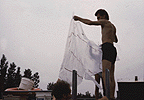Glossary
Back to "The Dive"
Homepage

Stapling and Designing on Plastic



Since the team was obligated to design much of the wreck in situ, that is underwater, plastic with lipstick as the drawing tool, was used by the divers. It is important to be able to understand how this was done since a majority of the physical research was compiled in this way.After an object was located the diver would ask for a large piece of plastic to be cut. The initial task was the stapling of the plastic, as well as possible underwater, to the artefact. Using lipstick, the diver then traced the outline, followed by any holes, grooves, markings, or other noticeable features on the object. As a rule these markings were generally difficult to understand underwater but it was essential to gather as much information as possible at this point.


When the diver had completed this part he removed the plastic and carried it to the surface. One the plastic was dry a member of the team retraced the design with a black felt pen. The lipstick not yet removed was then cleaned off. This left a life size design of the piece underwater which could be reduced (at a ratio) for analysis.


Since the underwater designing was very difficult, and its result were often less than that which could be done on the research vessel, it was preferable to bring the object to the surface. However, due to the weight of many of the larger object this was not always possible.